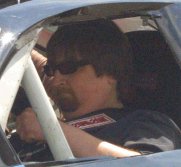
Brandon Reed
By Brandon Reed
Posted in Columns 9/4/09
I was fortunate enough earlier this week to get to witness a little piece of history.
On Monday, Micky Cain brought out the ASA Southeast Tour’s ride-along car and made the first laps at speed at Gresham Motorsports Park in Jefferson, Georgia.
In case you hadn’t heard, Gresham Motorsports Park is formerly Peach State Speedway. Towards the end of last year, the 42 year old speed plant was purchased by a group headed up by father and son Jim and Tony Gresham, whose roots in auto racing go back a long ways.
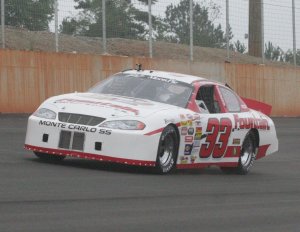
Micky Cain turns the first laps at speed in a race car at Gresham Motorsports Park, formerly Peach State Speedway, in Jefferson, Georgia. Photo by Brandon Reed
Gresham Motorsports Park is the latest in a series of names the track has held since it opened in 1967. It began as Jefco Speedway, and then became Georgia International Speedway in 1983 and later Peach State Speedway in the mid 90’s.
When word came down that the track was up for sale, there were lots of questions as to its future. Since the late Rob Joyce left in the mid ‘90s, the track had a series of bad breaks, mostly stemming from the management side.
But when the Gresham family came onboard, things changed.
Under Tony and Jim’s leadership, General Manager Dan Elliott and Administration Director Ben Finley have done a great job in getting the track moved forward. While the size and scope of the speedway itself has stayed the same, they’ve flipped the front and back stretches, built new grandstands, constructed a new infield facility and added a legends track. They moved the speedway not only into the modern day, but have moved it ahead of the curve by planning for it to be a multi-use facility.
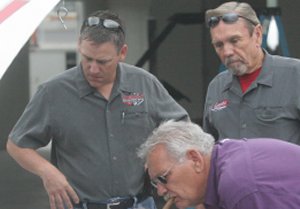
Tony Gresham, pictured left, and Jim Gresham, pictured right, have a look at Cain's car between runs. Photo by Brandon Reed
It will be the best thing that has happened to the facility since it hosted two NASCAR Sprint Cup events in 1968 and 1969. It will ensure the future of the speedway for years to come.
With that being said, here’s my point. GARHOFA historian and CEO Mike Bell told me once that there are a total of roughly 175 active and inactive race tracks scattered throughout Georgia. Over the next several months, he and I will be working to travel to the site of each track to obtain GPS coordinates that will allow us to always know where the tracks were or are located.
I’ve been able to explore a few of these tracks, such as the old Hall County Speedway. It’s interesting to venture back and look at what’s left, such as retaining walls and even infield buildings.
But it’s also sad. As I moved around the old speedway, I found the backstretch overgrown by trees. The front stretch was all but washed away. You could still see the pilings for the grandstands in the bank. There was even a rusted hood from a ’56 Chevy modified leaning against a nearby tree.
What made these tracks fail? What made them close up?
For some it was a lack of funding. For others, it was poor management. Some had bad luck. Others saw disaster, such as the old Jackson County Speedway, where one driver and two spectators lost their lives, or the Yellow River Drag Strip, where 11 spectators were killed in a terrible accident that was nobody’s fault.
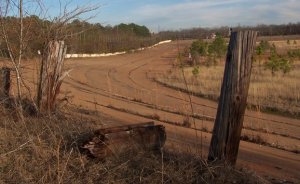
Middle Georgia Raceway, once one of the most popular tracks in the state, sits rotting away now in Byron, Georgia. The last race run at the facility was in 1984. Photo courtesy Henry Jones
Look at the Middle Georgia Raceway. Today, it sits near Byron, Georgia all but abandoned. NASCAR ran there for several years, with the likes of Richard Petty, David Pearson and Bobby Allison all recording Sprint Cup wins there. It would be a mainstay on the Late Model Sportsman and All Pro circuits.
The track was a high banked paved half mile, much like Gresham Motorsports Park. The difference, drivers say, came in the transition coming off of the banking. Middle Georgia was a sudden, quick drop, while Gresham has a smooth transition.
Regardless, the track was fast and it was competitive.
But now it sits empty, its last race having been run in 1984. Grass grows through the asphalt. The concrete stands have become rickety. The guardrail is gone.
It’s a track that has all but been forgotten and abandoned, a relic of the past. Its future remains cloudy, but it’s unlikely anyone will ever be allowed by the local government to reopen it.
Another perfect example of a track lost to us is in nearby Macon, Georgia.
The Central City Speedway actually consisted of two tracks, a one mile fairgrounds dirt oval and a smaller half-mile dirt track inside the first and second turns of the big track.

Marshall Teague and Tim Flock (91) lead the field at the start of the 1951 NASCAR event at Central City Speedway in Macon, Georgia. Photo courtesy the Jesse James Taylor family.
The half-mile was an amazing facility, years ahead of it’s time, with huge covered grandstands, sprawling infield facilities and a terrific racing surface.
NASCAR raced there from 1951 through 1954 with the Grand National circuit. Legendary drivers such as Gober Sosebee, Lee Petty, Dick Rathman and Herb Thomas won there.
But the local media wouldn’t get behind the facility. It was all but ignored. Without that local support, the bigger racing circuits stopped coming, and eventually both tracks were gone.
That beautiful half-mile is completely gone, now covered by ball fields. The layout of the one-mile track remains around a parks and recreation facility.
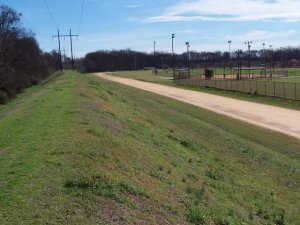
The site today of the Central City Speedway. The half-mile is completely gone, with the outline of the mile track remaining. Photo by Joe Cawley
And that’s the point of all this. If you have a local race track that you love, then you have to support it. You have to go out there on Saturday night or Friday night or Wednesday night and pull for the drivers and support your local race track.
There’s more to it than just racing. Race tracks give to the area economy. When a big show is hosted, drivers and crew members stay in local hotels. They eat in local restaurants. Their friends, wives and girlfriends shop in local stores.
But if you’re a race fan, your local track is just that – YOUR track. People that live around what is now Gresham Motorsports Park still refer to it as Jefco or Peach State. For those people, it doesn’t matter whose name is on the deed. It’s their race track. They will be there Saturday night or Sunday afternoon. They don’t care what football game or big time racing event may be on television. They’ll be in the stands at their race track, pulling for their drivers.
And that’s how it should be. If you love racing and you love that track, go out there and support it. Otherwise, like so many before it, that track could be boarded up, closed and gone before you know it.
Trust me, the full impact of that doesn’t hit you until you’re walking around one of these abandoned speedways, seeing what has grown in a spot where so many came to race and to see races.
It’s truly a heart breaking feeling to see what was once a proud speed palace reduced to dust and weeds.
None of us wants to see that happen to our own hometown race tracks.
Brandon Reed is the webmaster and editor for Georgia Racing History.com.
Questions, comments, suggestions? Email us!
This website is not affiliated with or endorsed by the Georgia Racing Hall of Fame or the Georgia Auto Racing Hall of Fame Association, Inc. All content is the intellectual property of the individual authors. All opinions are those of the individual authors. Please do not repost images or text without permission.
